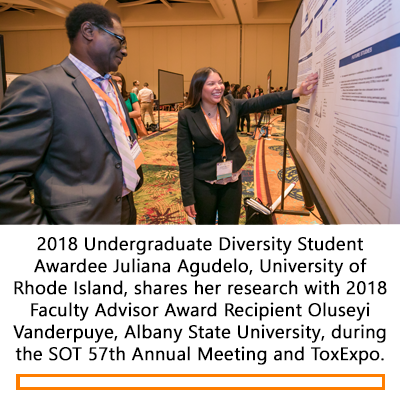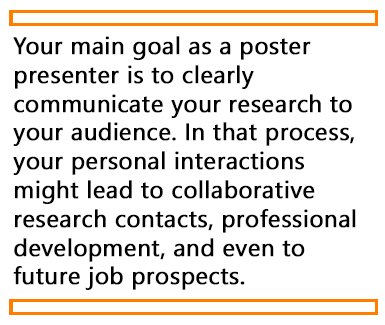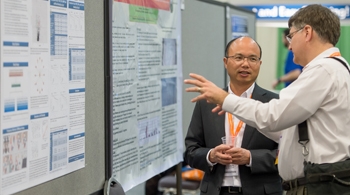
“Poster presentations are extremely important because one never knows who is going to be there or might seek out the work that is being presented,” says Christopher R. McCurdy, PhD, who is a professor of medicinal chemistry at the University of Florida College of Pharmacy. His research focuses primarily on opioid biochemistry, pain management, and treatment.
 Dr. McCurdy has experienced first-hand the importance of poster presentations during scientific meetings. Several years ago, Dr. McCurdy sent one of his students to a conference in San Francisco to present their research. During the Poster Session, Dr. McCurdy’s student was approached by a researcher from Stanford University who was intrigued by his work and interested in a collaboration to convert their compound into a radiolabeled version that could visualize the sigma 1 receptor.
Dr. McCurdy has experienced first-hand the importance of poster presentations during scientific meetings. Several years ago, Dr. McCurdy sent one of his students to a conference in San Francisco to present their research. During the Poster Session, Dr. McCurdy’s student was approached by a researcher from Stanford University who was intrigued by his work and interested in a collaboration to convert their compound into a radiolabeled version that could visualize the sigma 1 receptor.
For those who are not familiar with opioid biochemistry, sigma receptors are involved in pain. In 2016, more than 60,000 Americans died due to drug overdose, which is more deaths than from homicides and accidents combined. Around 80% of these drug overdose deaths were from opioids, specifically prescription painkillers. In the context of the opioid-death epidemic in the United States, developing a sigma receptor ligand to visualize pain can have enormous clinical applications in detecting not only the exact location of the pain but in treating it specifically.
For Dr. McCurdy to test the effectiveness of this ligand to visualize pain, his lab carried out studies where they surgically induced nerve damage in a rat’s leg and allowed the animal to heal for a month. The imaging studies indicated that the area of nerve damage showed a significant increase of radiotracer uptake, meaning that they could detect the localization of pain.
“Now, we have approval by the US FDA to move forward in Phase I clinical trials. All of this happened from one poster presentation!” shares Dr. McCurdy.
I believe there are two main benefits of participating in Poster Sessions. First, from a sociological perspective, you are participating in a dynamic idea exchange that exemplifies the collective, progressive nature of science. You, together with thousands of other scientists, are contributing to and creating the current foundation of toxicology and pharmacology—and influencing the direction of research and theory. Perusing poster presentations during events like the SOT Annual Meeting provides a bird’s-eye view of the collective progress made in tackling the biggest challenges in toxicology, including topics such as new hazards; toxicant mixtures and chemicals; individual susceptibilities and vulnerable subpopulations; and innovative approaches in drug development. Thus, the idea exchange with your colleagues during Poster and Platform Sessions is a powerful force that shapes the direction of toxicology.
 Second, from an individual perspective, through the personal contacts you establish during poster presentations, you may be opening many doors for networking opportunities and collaborations. This is perfectly illustrated by Dr. McCurdy’s student presenting at a scientific meeting. Your main goal as a poster presenter is to clearly communicate your research to your audience. In that process, your personal interactions might lead to collaborative research contacts, professional development, and future job prospects—or, in case of Dr. McCurdy’s student, a great dissertation.
Second, from an individual perspective, through the personal contacts you establish during poster presentations, you may be opening many doors for networking opportunities and collaborations. This is perfectly illustrated by Dr. McCurdy’s student presenting at a scientific meeting. Your main goal as a poster presenter is to clearly communicate your research to your audience. In that process, your personal interactions might lead to collaborative research contacts, professional development, and future job prospects—or, in case of Dr. McCurdy’s student, a great dissertation.
Of course, the very idea of personal interactions at Poster Sessions can generate social anxiety, especially in graduate students or early career researchers. Many graduate students are taught to keep their poster spiel under three minutes, speak enthusiastically and clearly, and deliver key messages in a logical flow. These are classic rules to follow, but there is more you can do to get the most out of your presentation: focus on piquing your listener’s curiosity regarding your research and maintain a dynamic dialogue between you and the viewers.
Marilynn Larkin, an award-winning science writer and editor, advises presenters to focus on what the audience is interested in hearing—in addition to what you want to say. Give your listeners a reason to care about your research topic: Appeal to your audience’s interests and stir their curiosity by using provocative questions to identify why your research is meaningful and worth their time. Once you spark curiosity and self-relevance in your audience, they will be happily engaged.
 Finally, a poster presentation is a dynamic dialogue between you and your viewers. It is critical to engage in this dialogue with an open attitude. Others will share new perspectives on how to apply or extend your project, raise new questions, or suggest a different analysis of your results. Keeping an open mind to others’ ideas is a prerequisite for establishing a meaningful connection and to get the most out of the dialogue.
Finally, a poster presentation is a dynamic dialogue between you and your viewers. It is critical to engage in this dialogue with an open attitude. Others will share new perspectives on how to apply or extend your project, raise new questions, or suggest a different analysis of your results. Keeping an open mind to others’ ideas is a prerequisite for establishing a meaningful connection and to get the most out of the dialogue.
So, next time when you are presenting a poster at a scientific meeting, think about the “butterfly effect” in the context of your own scientific career. Seemingly small events, like a question from your audience or a personal interaction, can change the directionality of your research project or facilitate an interview at your dream company.
Editor’s Note: SOT is currently soliciting abstract submissions for the 2019 Annual Meeting and ToxExpo. Suggestions and tips for developing your abstract are available on the SOT Annual Meeting website, where you also can find instructions and information on submitting your abstract. The abstract submission deadline is October 19.